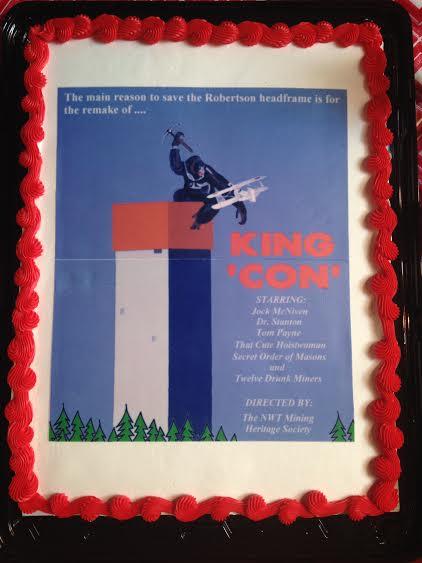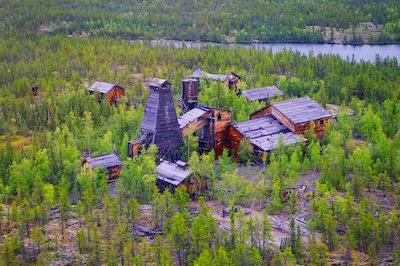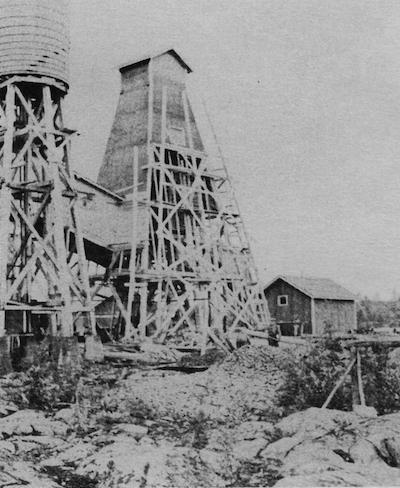Construction Season Wraps Up
Another summer of renovations and construction at the Giant Mine museum site have wrapped up. Eddie Paul’s crew with Nextreme Steel Specialists, our primary contractor, focused on the recreation hall building again this year, with significant interior gutting and re-flooring accomplished throughout the structure. The crew also performed some work to recontour the ground around the Commissary storage building, to help divert spring melt away from the building.
The Giant Mine remediation project has also now received government approval. We are currently in discussions with the cleanup team about how this will affect our activities at the museum site. We are also looking for further clarification on our rights as tenants of this area, and the future use of the A-shaft and commissary buildings. We are also hoping that the fence around our outdoor display at the boat launch parking lot can be removed as we understand there is no immediate danger from shaft tunnels in this area.
Some of the other projects accomplished this fall include: continued cleaning of our storage space and organizing our artifact collection, monitoring of temperature and relative humidity conditions in our buildings, and working on the outdoor display area to install plaques and shuffle around machinery. The outdoor display continues to be a huge draw for visitors to the city.
Website Launched
The newly designed website of the NWT Mining Heritage Society is now launched. It was designed by Kellett Communications after months of consultation by a small working group. The old website was wrought with problems and we no longer had administrative access to the content. The new site is a huge improvement and we welcome everyone’s feedback. There remain some features which will be developed over the winter, including a ‘Shop’ page and a member’s portal section. Thanks to board directors Tracey Breitbach, Ryan Silke, and Helmut Epp for their work on the new site.

Annual General Meeting
The 2014 annual general meeting was held on September 8, at the Northern Frontier Visitors Centre. President Walt Humphries read an update on the past years activities which are summarized in this newsletter. No election for the board was held this year, but one new nomination was approved to replace resignations this summer: Terry Warner of Tetra Tech Engineering. The meeting was complimented with a BBQ and refreshments, a slideshow of Beer Barge photos, a 'King Con' save the Robertson headframe cake, and the launch of the new website.
Beer Barge 2014
The NWT Mining Heritage Society would like to thank all our wonderful sponsors, supporters, and volunteers of the 6th annual Beer Barge 2014. It was our most successful event yet! A special thanks to Max Ward for the use of his dock and to everyone that helped with cleanup afterwards. And thanks to everyone who came in costume! The 2014 Beer Barge was a resounding success and we could not have done it without you. Thanks for keeping the tradition alive!
BEER BARGE SPONSORS
Canadian North, Aurora Geosciences, Williams Engineering, For Women Only, RTL Construction, Territorial Beverages, Superior Propane, Northern Frontier Visitors Centre, Quality Furniture, W.J. Humphries Mineral Exploration, East Arm Freighting, Dave Smith, Frank Hurcomb, Klaus Schoenne of Tru Value Hardware, Joy Watt, Lynn Elkin of Ptarmigan Productions, Yvonne Quick, Lisa Tesar of Bottomline PR, Willy Mammoth, Greyson Gritt, Pido Productions, Robert Hawkins, Bob Bromley, Daryl Dolynny, Angela Goodwin…and all the many volunteers!
Forest Fires Destroy Mining Heritage
The summer of 2014 will go down in Yellowknife history as one of the worst forest fire seasons on record. Wildfires raged throughout the NWT and particularly to the north and east of the city, where the flames destroyed many sites of significance to local mining and prospecting heritage.

The largest fire was along the Beaulieu River, 70 to 90 kilometers directly east of Yellowknife. Many gold and tungsten deposits were explored and mined in this area in the 1940s, and most of the camps left behind by the prospectors have undoubtedly been lost. The biggest loss, in terms of preserved mining architecture, was the abandoned Ruth gold mine, located 90 kilometers east near Francois Lake. The gold deposit was discovered in 1940 and developed by Cominco. It was a very isolated gold deposit so they had to plow a winter road up from Hearne Channel on Great Slave Lake in 1942 to bring up machinery. A crew of 40 men worked throughout the spring and summer to bring that mine into production. This was at the height of the World War and gold mines throughout Canada were struggling. Cominco had a lot of money backing it together with a lot of faith in the Yellowknife district. But the mine only operated for two weeks in August 1942. And they left behind quite the preserved site. The miners had a really nice camp there on a scenic little lake. The guys put a lot of hard work into getting that mine built and it was a shame it only lasted two weeks. They were planning for a very cold winter and cut up thousands of cords of wood for their barrel heaters. It was left to rot in the bush and even today, after the flames, you can still see the blackened cords stacked up in the bush.
It would have been great to see the Ruth Mine preserved as an example of an early mining operation. It was fully intact….headframe, mill, shop, cookhouse, bunkhouse, superintendent’s house. Unfortunately, the site was isolated and difficult to get to, meaning that running it as part of a tourism package would have been difficult to organize. The Federal Government had planned to remediate the site to the forest fire has accomplished part of the job for them. The mining museum planned to salvage some of the machinery in the event of a cleanup. Lots was destroyed, but hopefully some of the machinery can be saved or left there as a monument.
A few other mining sites were destroyed. Most notable in Yellowknife history was Lou Garskie’s old cabin north of Prelude Lake. Between 1947 and 1972, Garskie worked a very rich gold claim, usually by himself, and with no mechanical tools. He would famously strut around town showcasing beer bottles and Coke bottles full of gold nuggets. His little log cabin was a testament to the one-man gold mine. It too was destroyed by the forest fires. Two other mine sites were burned as well: the Viking gold mine along the Yellowknife River, and the Spectrum Lake site also in the Beaulieu River region. We estimate that aside from the Giant, Con, and Ptarmigan Mines near Yellowknife, there are now NO old mine headframes left standing in the Northwest Territories.
In memory of the Ruth Mine, here is an excerpt from the Cominco Magazine issue of October 1942 entitled ‘Shots from Ruth’ by Harold Shannon:
“If a crow left Yellowknife at noon and flew due east at the rate of 57 miles per hour, it would be over Ruth when the one o’clock whistle blew. Thirty-seven miles away is Francois Bay, a large arm of Great Slave Lake. The mine, itself, is located on a small lake – about a mile long by a quarter mile wide – which is not connected by water with the main lake.
Construction started on the property on April 25 [1942], the objective being to have the mill and camp buildings completed and the mill in operation by July 1. Our goal would have been attained had it not been for the lack of transportation due to the scarcity of aircraft upon which this property is wholly dependent during the summer season for connection with the cold, cruel, outside world.
The operating was thus delayed until July 30 when the first ore was crushed during a trial run. With the exception of a few minor adjustments that had to be made, the success of the run was far above expectations. This measure of success was due, in no small part, to the experience and forethought of the engineers in charge, namely: O.H. Gill, mechanical superintendent of the North Central District; J.W. Donaldson, Ruth superintendent; P.M. Elliot, superintendent of the Outside Mills; and W.G. Jewitt, superintendent of the North Central District.

The property is under the supervision of Mr. J.W. Donaldson who, with his wife, moved here on the first of April when there was nothing in the way of accommodations except tents. The mill is under the supervision of H.R. Bianco who has been with the company for five years, during which time he has been on practically all company properties, the latest being Ptarmigan where he gave up his work to take charge of the Ruth mill. Bob, as he is known to all of us, is looking forward to treading the straight and narrow soon when he will have a few days off to return with his bride to make his home on the property.
The camp is built to accommodate 40 men and the staff. This is considered a full crew for the present 25-ton capacity. There is little social activity as the men work seven days a week and about 35 to 40 days a month – and that’s no figure of speech as they work plenty of overtime. Main social events – if they can be called such – were the July 1 holiday when everyone had the day off and a good time, and the arrival of a set of boxing gloves in July. Everyone in camp had a set-to with the gloves, and several aspiring Joe Louis challengers were absent from work the next a.m.
One fishing expedition ended up all wet when two hardy fishermen, McInnes and Anderson, who had imbedded something stronger than water, felt that dangling a hook was too slow a method of fishing, so promptly went overboard – clothes and all. They were hauled safely ashore after their adventure with the aid of a rope.
There has been considerable fishing and canoeing on our little lake this summer. Many of us, however, do miss the feminine touch that adds so much to an evening’s canoeing trip. What with calm waters, a silvery moon, a whispering zephyr, and all that, who wouldn’t want what it takes to make a perfect evening? In spite of the lack of the opposite sex, we certainly consider ourselves lucky to have canoes and a lovely lake beckoning a few hundred yards from the camp.”